Amacrine cells
| Amacrine cell | |
|---|---|

|
|
| Details | |
| Location | INL of the retina |
| Morphology | Varies |
| Function | inhibitory or neuromodulatory interneurons |
| Neurotransmitter | gamma-Aminobutyric acid, glycine, DA, or 5-HT |
| Presynaptic connections | Bipolar cells |
| Postsynaptic connections | Bipolar cells and Ganglion cells |
| Identifiers | |
| NeuroLex ID | Amacrine Cell |
|
Anatomical terminology
[]
|
|
Amacrine cells are interneurons in the retina. They are named from the Greek roots a– ("non"), makr– ("long") and in– ("fiber"), because of their short neuritic processes. Amacrine cells are inhibitory neurons, and project their dendritic arbors to the inner plexiform layer (IPL), there interacting with retinal ganglion cells and/or bipolar cells.
Amacrine cells operate at the inner plexiform layer (IPL), the second synaptic retinal layer where bipolar cells and retinal ganglion cells form synapses. There are at least 33 different subtypes of amacrine cells based just on their dendrite morphology and stratification. Like horizontal cells, amacrine cells work laterally, but whereas horizontal cells are connected to the output of rod and cone cells, amacrine cells affect the output from bipolar cells, and are often more specialized. Each type of amacrine cell releases one or several neurotransmitters where it connects with other cells.
They are often classified by the width of their field of connection, which layer(s) of the stratum in the IPL they are in, and by neurotransmitter type. Most are inhibitory using either gamma-Aminobutyric acid or glycine as neurotransmitters.
As mentioned above, there are several different ways to divide the many different types of amacrine cells into subtypes.
GABAergic, glycinergic, or neither: Amacrine cells can be either GABAergic, glycinergic or neither depending on what inhibitory neurotransmitter they express (GABA, glycine, or neither). GABAergic amacrine cells are usually wide field amacrine cells and are found in the ganglion cell layer (GCL) and the inner nuclear layer (INL). One type of GABAergic amacrine cell that is fairly well studied is the starburst amacrine cell. These amacrine cells are usually characterised by their expression of choline acetyltransferase, or ChAT and are known to play a role in direction selectivity and detection of directional motion. Acetylcholine is also released from these amacrine cells, but its function is not completely understood. Another subtype of GABAergic amacrine cells are those that are dopaminergic. These are all TH expressing and these amacrine cells modulate light adaption and circadian rhythm. These are widely spreading amacrine cells, and they diffusely release dopamine, while still releasing GABA and carrying out all normal synaptic release. Many other divisions of GABAergic amacrine cells have been noted, but those listed above are some of the most extensively researched and discussed.
...
Wikipedia
